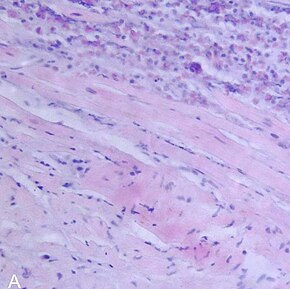| Endomyocardial biopsy | |
|---|---|
 Endomyocardial biopsy showing myocarditis | |
| Purpose | Surveillance of rejection following heart transplantation |
Endomyocardial biopsy (EMB) is an invasive procedure used routinely to obtain small samples of heart muscle, primarily for detecting rejection of a donor heart following heart transplantation. It is also used as a diagnostic tool in some heart diseases.[1]
A bioptome is used to gain access to the heart via a sheath inserted into the right internal jugular or less commonly the femoral vein.[1] Monitoring during the procedure consists of performing ECGs and blood pressures.[1] Guidance and confirmation of correct positioning of the bioptome is made by echocardiography or fluoroscopy.[1]
The risk of complications is less than 1% when performed by an experienced physician in a specialist centre.[1] Serious complications include perforation of the heart with pericardial tamponade, haemopericardium, AV block, tricuspid regurgitation and pneumothorax.[2]
EMB, sampling myocardium was first pioneered in Japan by S. Sakakibra and S. Konno in 1962.[1][3]
- ^ a b c d e f Asher, Alex (July 2017). "A review of endomyocardial biopsy and current practice in England: out of date or underutilised?". The British Journal of Cardiology. Retrieved 26 September 2018.
- ^ Marini, Davide; Wan, Andrea (2019). "34. Endomyocardial biopsies". In Butera, Gianfranco; Chessa, Massimo; Eicken, Andreas; Thomson, John D. (eds.). Atlas of Cardiac Catheterization for Congenital Heart Disease. Switzerland: Springer. pp. 295–300. ISBN 978-3-319-72442-3.
- ^ Melvin, Kenneth R.; Mason, Jay W. (15 June 1982). "Endomyocardial biopsy: its history, techniques and current indications". Canadian Medical Association Journal. 126 (12): 1381–1386. ISSN 0008-4409. PMC 1863164. PMID 7044509.